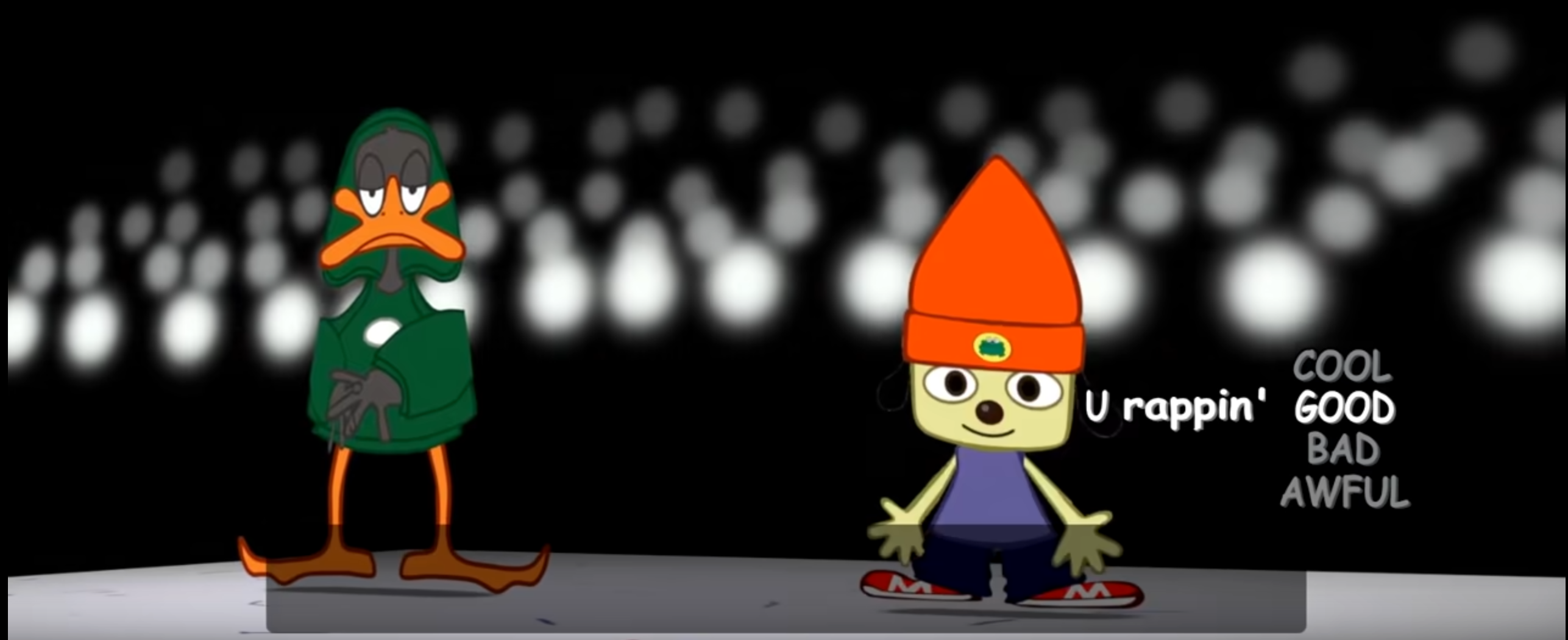
For my retro game review, I turned to PaRappa the Rapper, a video game released for the PS1 in 1996. It’s widely attributed as being the original rhythm game, and although I played it neither in 1996 (it was ’08) nor on the PS1 (it was the PSP) it was also my first rhythm game, and set me on a path to being obsessed with modern rhythm games like BeatSaber and Friday Night Funkin’. (Highly highly recommend these.) The game follows a cartoon dog, PaRappa, getting a series of lessons in the form of raps in order to compete with another guy for a girl. As he learns skills like baking cakes or how to drive, he also has to deal with problems of his own making, like needing to buy his dad a new car after crashing it (10 minutes after getting his driver license, to be precise, which is something that I ALSO almost did) or needing to use the bathroom and dealing with a long line. PaRappa’s antics are quite honestly, really stupid, and all the levels are absolutely ridiculous (if you drove like he does for his lesson, you’d probably get arrested) but the game is very enjoyable and playful.
The gameplay is pretty standard as far as rhythm games go – PaRappa’s teacher raps a line, then you have to repeat the line and you get points for accuracy. If you mess up enough, you lose. However, one of the things that sets it apart from modern rhythm games is that there’s a floor for passing the level. In modern rhythm games, making it till the end of the song is adequate. In PaRappa, you have to score at least a good on the U rappin’ meter. Honestly, I think this is a mechanic that should have been left behind, because you can finish a song and not succeed, which is a feelsbad for the player and creates an unnecessary failure state. In many rhythm games, just surviving is rewarding enough, and to be hit with a loss after barely hanging on throughout the level is very frustrating.

That being said, it also has a freestyle mode that shows up in the last level and also can be used in the regular levels once you’ve beaten the game. Instead of the formula of call and repeat, the player actually has to freestyle themselves and chain buttons to make their own raps. Although it feels frustrating at times (like it being at the end of the final level) it breaks the formula. It looks for something different in a rhythm game, improv, which isn’t usually accounted for. In this way I think it’s controversial, but it is certainly unique. It does feel funny to me to say that it’s doing something “different” than other rhythm games because it is one of, if not the, earliest rhythm games out there.
The art style is also unique, with a semi 3d space composed of paper cutout characters. All the characters and backdrops are flat and thin as a piece of paper. Its bright visuals and cartoony characters is still reflected in modern rhythm games like FNF. Additionally, PaRappa is notable for having dynamic sets, with each level’s backdrop/environment changing with your performance. For instance, in the second level, where PaRappa is getting his drivers license, the car begins to swerve all over the road if you drop to either Bad or Awful performance. The demeanor of your teacher changes as well, with them growing more angry as you fail, indicating PaRappa’s failure to comprehend the lesson. One of the most creative ways this is expressed is in Level 4, when PaRappa is on a cooking show. When rapping well, there’s a tv cutout surrounding the screen, with an audiovisual filter making it look and sound like an old time TV.

A key point of enjoyment for me was the silly, goofy narrative that didn’t take itself too seriously. My favorite level in the game, level 5, takes the teachers of the last 4 levels and turns them into competitors for, of all things, a line to use a portapotty in the rain. PaRappa has to battle each of them one by one to get to the front of the line, because for some reason, everyone needs to use the bathroom at this one location in the pouring rain. Not only is this a goofy premise, it also serves a gameplay purpose: It revisits each teacher, and their rhythms, but turns it on its head. They have the same beat, and a lot of the same words, but now they’re talking about really, really needing to use the bathroom. This illustrates a mundaneity that I don’t see in a lot of video games, which often have power fantasies tied into them. But sometimes, you just really gotta go, and so do a bunch of other people. It’s nice to be reminded that sometimes, video game characters really need to use the bathroom too.



I rate this review a u rappin’ cool out of 10